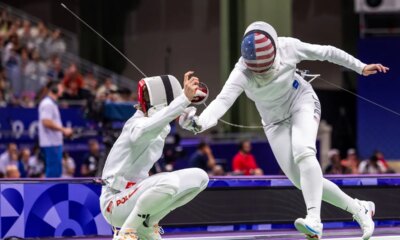Culture
Why Caitlin Clark could pose a dilemma for Team USA at the Olympics

USA Basketball will be seeking its eighth consecutive Olympic gold medal this summer with the first step coming at the Olympic qualifying tournament in Antwerp, Belgium, from Feb. 8-11. The 12-player roster for that tournament will be the first approximation of the team that will defend the Americans’ gold medal in Paris.
Based on the 18 players who have been invited to the national team camp from Feb. 2-4 in Brooklyn, N.Y., the committee has a terrifically challenging task to select that final roster, a decision that will likely be further complicated by the current collegians — primarily Caitlin Clark, but USA Basketball veterans Paige Bueckers and Cameron Brink could also factor in here — who turn pro at the end of the 2023-24 season.
The final roster will ultimately make a statement about what the committee values: youth and the future or experience and proven success. USA Basketball has generally balanced old and young on the international team so that the younger players can carry the torch and preserve the culture. Including — or not including — Clark poses a unique dilemma with the wealth of options before the committee.
18 athletes will be in camp with the 🇺🇸 #USABWNT Feb. 2-4 in prep for the #FIBAOQT in 🇧🇪 Antwerp.
— USA Basketball (@usabasketball) January 23, 2024
On the opposite end of the spectrum from Clark is Diana Taurasi, one of eight Olympians from Tokyo in 2021 who is back in the national team pool. Taurasi is seeking to become the first basketball player of either gender to compete in six Olympics. She would also be the oldest basketball Olympian ever and the third American woman of any sport to participate in six games. Assuming Taurasi is healthy, she is a lock to return to the roster. The 41-year-old even participated in the USA Basketball college barnstorming tour in November against Tennessee and Duke, which presumably was not compulsory for a player with her pedigree.
Taurasi is joined by Ariel Atkins, Napheesa Collier, Chelsea Gray, Brittney Griner, Jewell Loyd, Breanna Stewart and A’ja Wilson from the Tokyo team. Atkins is the only one of those returnees — other than Griner, who has extenuating circumstances, and is another lock to suit up in red, white and blue if she so chooses — whose play has declined since the last Olympiad, but considering she also played for the USA during the 2022 FIBA World Cup, Atkins will likely be prioritized by the committee. However, her status as a 2024 Olympian is probably the most tenuous of these eight players.
That leaves at most five, and likely four, spots for new blood, and the competition is fierce. Kahleah Copper, Sabrina Ionescu, Betnijah Laney, Kelsey Plum and Alyssa Thomas were all additionally part of the World Cup squad. Ionescu averaged the fewest minutes in Australia, but she, Thomas and Plum all have been All-WNBA selections within the past two seasons, with the latter two finishing top-five in MVP voting. Plum’s history with the three-on-three team should also give her a leg up with the committee, which brings us to her fellow gold medalists in that sport’s debut in 2021: Allisha Gray and Jackie Young. Both players seem too good to be left off of the roster, especially Young, but that is always the case with the American national team.
All seven of those players would be reasonable selections for the Olympics, and that doesn’t even include Aliyah Boston, Rhyne Howard and Arike Ogunbowale — three of the younger camp invites. All Boston has done is put together one of the most decorated college careers in recent memory, plus collect multiple gold medals for the U.S. at youth levels, while earning rookie of the year honors and starting in the WNBA All-Star Game. Frankly, Boston seems like another lock, filling in the sixth frontcourt spot behind Wilson, Stewart, Griner, Thomas and Collier. Howard and Ogunbowale — both All-Stars who would be the leading scorers on just about any other national team in the world — are probably on the outside looking in until the 2028 Olympics.
Then, there’s the youth question. The No. 1 picks in the 2004, 2008 and 2016 WNBA drafts made the Olympic teams as rookies (Nneka Ogwumike’s omission in 2012 was curious then, and her absence from subsequent Olympic rosters has made that snub even more ridiculous in hindsight), and a similarly loaded draft class is on deck to carry that tradition. The youngsters take their place at the end of the roster and then grow into the future leaders. Wilson has talked about learning from Taurasi and Sue Bird how to set the standard, which she put into practice along with Stewart at the last World Cup.
It would make sense for Clark to be the latest ingénue to take her place as Team USA’s 12th player, but with the 2004 No. 1 pick Taurasi still kicking, there may not be enough space. Perhaps the committee will take solace in Boston representing the current generation, while a cohort of older guards compete in the backcourt. Deciding between Atkins, Copper, Allisha Gray, Ionescu, Ogunbowale, Plum and Young for what figures to be three spots will be difficult enough without adding Clark to the mix.
Then again, the Caitlin Clark effect is real. How could USA Basketball choose not to capitalize on the rabid popularity of one of the game’s biggest stars when whoever takes her place doesn’t figure to play many minutes anyway? The Olympics are the biggest showcase of women’s basketball worldwide. A player like Clark belongs on that stage if the selection committee wants to build off the momentum the sport is generating stateside.
There will be plenty of superstars on the national team whether Clark makes the cut or not. And the U.S. will be prohibitive favorites regardless of what combination of these players suits up in Paris. The specific composition of this roster, however, will reveal what the committee prioritizes, be it national team history, domestic success, balance of youth/veterans or the most marketable names. All of those possibilities are on the table.
(Photo of Caitlin Clark: Marc Piscotty / Icon Sportswire via Getty Images)

Culture
Which Notable Book of 2025 Should You Read? Let Us Help You.

We’ve released our list of 100 Notable Books. (You can read it in full here!) Browsing a list of 100 books is exciting, but can be overwhelming. Want to find one to read right away? We can help! Here is a cheat sheet to the list, broken into categories. Clicking a book cover will take you to the full review.
Let’s ease into things. How about a book I can read in a day?
Give me a novel that takes me back in time
Actually, give me a nonfiction book that takes me back in time
I need a crowd-pleaser for my book club — the longer, the better
I’m in the mood to laugh!
I’d like a rich, immersive thriller
I want insight into current events
Are there books that will make me swoon?
How about some fantasy?
I’d like an absorbing memoir or biography
I love family sagas — real or imagined
I like to be scared
I’m hungry!
I want to read about the creative process
Take me somewhere far, far away
I could use a good, cathartic cry
Culture
Can You Identify Lines From These Classic Science Fiction Novels?

Welcome to Literary Quotable Quotes, a quiz that tests your recognition of memorable lines. This week’s installment highlights lines from notable 20th-century science fiction novels. In the five multiple-choice questions below, tap or click on the answer you think is correct. After the last question, you’ll find links to the books if you want to experience the entire work in context.
Culture
Do You Recognize These Past Winners of the National Book Award?

Welcome to Lit Trivia, the Book Review’s regular quiz about books, authors and literary culture. In honor of the National Book Awards presented by the National Book Association on Nov. 19, this week’s challenge celebrates winners from the past 20 years and asks you to identify a title by a short description of the work. In the five multiple-choice questions below, tap or click on the answer you think is correct. After the last question, you’ll find links to the books if you’d like to do further reading.
-
Business1 week ago
Fire survivors can use this new portal to rebuild faster and save money
-

 World1 week ago
World1 week agoFrance and Germany support simplification push for digital rules
-

 News1 week ago
News1 week agoCourt documents shed light on Indiana shooting that sparked stand-your-ground debate
-

 World1 week ago
World1 week agoSinclair Snaps Up 8% Stake in Scripps in Advance of Potential Merger
-

 Science4 days ago
Science4 days agoWashington state resident dies of new H5N5 form of bird flu
-

 World1 week ago
World1 week agoCalls for answers grow over Canada’s interrogation of Israel critic
-

 Politics1 week ago
Politics1 week agoDuckworth fires staffer who claimed to be attorney for detained illegal immigrant with criminal history
-

 Technology1 week ago
Technology1 week agoFake flight cancellation texts target travelers


























